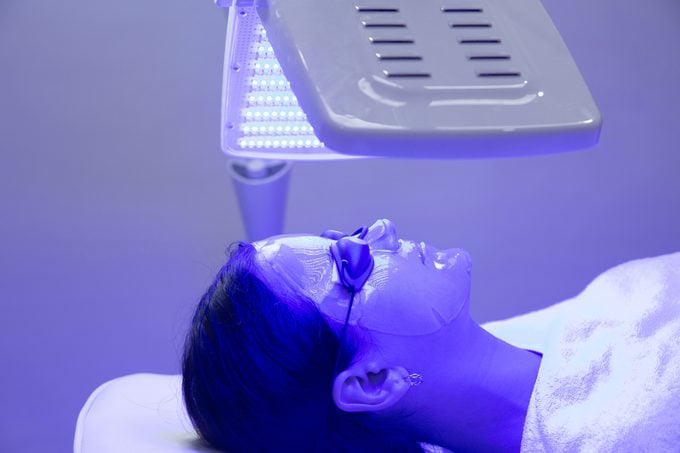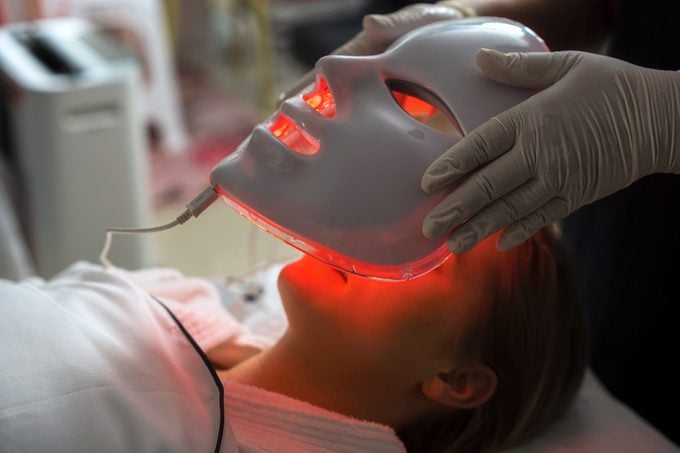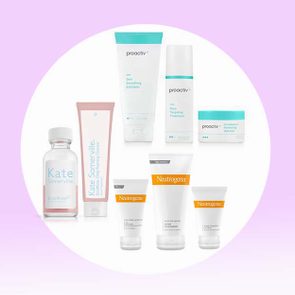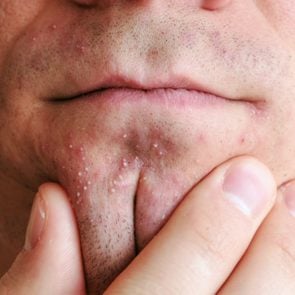Does Blue Light Therapy for Acne Work?
Updated: Feb. 01, 2021
Blue light therapy for acne is a treatment that's safe for many people. Here's how to know if it's a good option for you, according to dermatologists.
Our editors and experts handpick every product we feature. We may earn a commission from your purchases.
Sometimes acne is stubborn. Maybe you’ve tried all the best home remedies for acne or even a prescription acne treatment to no avail. It might be time to consider other treatments for your problem skin, like blue light therapy.
Does blue light therapy for acne work?
Although you may find it odd that light could affect the skin, but blue light therapy for acne is a well-researched treatment option. It works for treating acne caused by bacteria.
The wavelength of blue light has antimicrobial effects and kills Propionibacterium acnes, the most common type of bacteria that contributes to acne, according to Lindsey Bordone, MD, a board-certified dermatologist in the department of dermatology at Columbia University Medical Center in New York.
“Most studies on blue light therapy report significant improvement, some reporting as much as 90 percent of study participants with a reduction in acne,” Dr. Bordone says.
One study in the journal Drug Resistance Updates found that 77 percent of people with acne who had five weeks of blue light therapy treatment saw an improvement in their skin.
The treatment also has anti-inflammatory benefits, which decrease other symptoms of acne, such as redness, adds Annie Gonzalez, MD, a board-certified dermatologist, Riverchase Dermatology, in Miami. “Phototherapy [light therapy] is well-researched and, while there isn’t a cure for acne, it is a great treatment option to manage the condition,” she says.
Red light therapy is another phototherapy option for acne. In red light therapy, the skin is exposed to low levels of red light—similar to infrared light where you can feel the heat, except, unlike infrared light, you can see it. But this therapy isn’t yet FDA approved, unlike some blue light therapy devices for acne. (More on this later.)
Blue light is more common than the red light options, according to Dr. Gonzalez. Blue light therapy for acne is very safe and works well for nearly all patients with minimal side effects.
(Here are the surefire ways to get rid of acne once and for all.)
Who should try blue light therapy for acne?
People who are good candidates for this treatment include those with inflamed, red cystic acne, according to Dr. Gonzalez. “Really, most patients with inflammation and acne issues can benefit from blue light treatments because what the light is doing is ridding the skin, oil glands, and the pores of the bacteria that is causing the breakouts,” Dr. Gonzalez says.
Dr. Bordone recommends blue light therapy for acne patients who don’t respond to certain antibiotics or topical acne treatments. Other people who may want to consider blue light therapy are pregnant women and people concerned about taking oral medications that could have side effects or interact with their other medicines, Dr. Bordone says.
Note that blue and red light devices are not effective against blackheads, whiteheads, or nodules, according to the American Academy of Dermatology Association.

Who should avoid blue light therapy for acne?
Some patients on prescription medication may not be good candidates and should speak with their dermatologist for a final assessment. “Usually, this type of treatment is recommended to avoid medications, and it can be a good alternative because there aren’t dangerous or uncomfortable side effects,” Dr. Gonzalez says.
Two to three treatments of phototherapy a week for a period of three to six weeks is usually standard for patients who are new to blue light therapy, according to Dr. Gonzalez. Patients who don’t have time for regular weekly treatments won’t benefit from infrequent, inconsistent blue light therapy.
“The investment of time and lack of insurance coverage for this treatment can make this treatment less desirable,” Dr. Bordone says. “I infrequently recommend blue light therapy since insurance coverage is often a significant financial barrier for patients.”
(Here are the worst myths about the causes of acne.)
In-office blue light treatments vs at-home blue light treatments
In-office blue light therapy for acne treatments
At-home blue light devices have FDA approval, but they aren’t as strong as those used during in-office treatments, according to Dr. Gonzalez.
Dermatologists and aestheticians have access to advanced technology and products tailored to a patient’s needs, making it a good idea to do blue light treatments in-office, according to Dr. Gonzalez. “In-office, we usually combine it with a photosensitizer medication before exposure to the blue light to enhance its absorption, and this is called photodynamic therapy,” she says.
Acne breakouts can occur due to someone’s environment, diet, habit, sleep pattern, and other variables, too.
“Most experts would agree that to tackle acne, and even cure it, there needs a multifaceted approach of both in-office treatments and at-home routines,” Dr. Gonzalez says. “A skilled dermatologist or aesthetician can help build a combination of thoughtful treatments to deliver long-term results.”
What to expect from an in-office blue light therapy session?
The light therapy session can last anywhere between 15 minutes to 30 minutes. People should avoid retinol and other products that thin the skin two weeks before to avoid stripping it, Dr. Gonzalez warns.
“A trained professional or dermatologist will apply pulses using a blue light therapy tool to different areas of the face, working in circular motions,” she says. “They will continue this process several times until the treatment is completed.”
Expect a significant decrease in breakouts with the continued upkeep of blue light therapy. This type of light therapy is safe for every skin type, but mild redness and peeling may occur for at least 48 hours after.
Phototherapy also makes the skin more sensitive to sun exposure, so it is vital to be extra vigilant with sunscreen in the days following. It is good to skip steps in your everyday routines such as retinol, scrubs, and exfoliants to avoid irritation, Dr. Gonzalez says.
At-home blue light therapy for acne treatments
If you want to maintain in-office treatment results, there are many blue light products available for at-home use, according to Dr. Gonzalez. “Someone can use these products after cleansing their skin daily in combination with skin care products to achieve the desired results,” she says.
If you choose to try an at-home treatment, Dr. Bordone and Dr. Gonzalez recommend using eye protection to prevent damage to the eyes. Certain medications and eye conditions could make people more light-sensitive.
Dr. Bordone and Dr. Gonzalez point out that there is minimal long-term research on the efficacy and potential side effects of these at-home light therapy devices’ long-term use.
On the bright side, one small study focusing on 21 people in the Journal of Clinical and Aesthetic Dermatology found that those who did at-home, self-applied blue light therapy for 28 days reduced the amount of acne on their face.
“Many of these products are not as effective and lack the advanced technology that a dermatologist’s office may have,” Dr. Gonzalez says. “There is also slightly more risk involved when using these devices at home.” Someone may also damage their skin unintentionally if they don’t know the proper techniques. Not to mention, at-home options are usually pricey. But we did find a few below that may not break the bank.

Blue vs red light therapy for acne
Red and blue light therapy complement each other when treating acne because red light therapy targets inflammation and redness in the skin, according to Dr. Bordone. A dermatologist may use a combination of these lights to achieve maximum results since one stimulates elastin and collagen while the other fights bacteria and dead skin cells.
The biggest difference between the two is their bacteria-fighting properties. “Blue light has a shorter wavelength and focuses on destroying the bacteria on the skin’s surface that causes acne,” Dr. Gonzalez says. “Red light has a longer wavelength, which enables it to penetrate the skin deeper than blue light.”
Both work very similarly by boosting blood flow and improving overall skin tone and texture. However, red-light can help acne scars fade because it decreases inflammation. So red light therapy would be more favorable to someone combating aging signs, removing acne scars, and reducing inflammation, according to Dr. Gonzalez.
The bottom line
Blue light therapy for acne is a safe and effective treatment option for most people. It may not be the best course of action, however, for people who don’t have the time for multiple treatments. For people who want to cover their acne treatments with insurance, blue light therapy is probably not your best bet.
And if you opt for using blue light therapy for acne at-home, know that it’s not the same as having an in-office treatment with a licensed dermatologist.
















